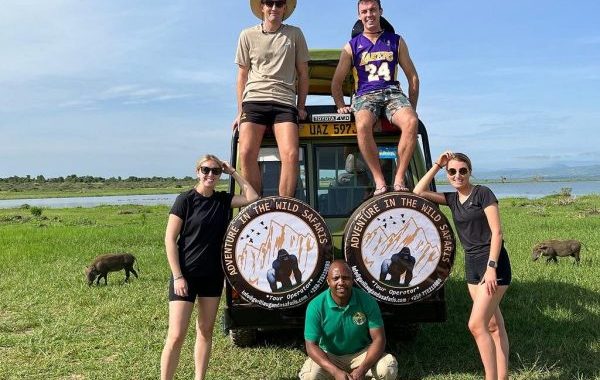Embarking on a gorilla trekking adventure in Uganda offers an unparalleled opportunity to witness the…
What Makes a Gorilla Beat Its Chest and Charge?
 One of the most iconic and powerful sights in the wild is a gorilla beating its chest—a deep, thunderous display that echoes through the forest. Often followed by a dramatic mock or real gorilla charge, this behavior captivates and sometimes intimidates anyone lucky enough to witness it. But what does it really mean?
One of the most iconic and powerful sights in the wild is a gorilla beating its chest—a deep, thunderous display that echoes through the forest. Often followed by a dramatic mock or real gorilla charge, this behavior captivates and sometimes intimidates anyone lucky enough to witness it. But what does it really mean?
The Meaning Behind Chest-Beating
Chest-beating is a form of non-verbal communication used by gorillas to convey strength, confidence, or alertness. It’s most often associated with silverback males, though younger gorillas and even females occasionally do it.
Reasons gorillas beat their chests include:
- Asserting dominance over others in the group or in nearby groups
- Intimidating rivals without engaging in physical conflict
- Signaling readiness to mate or attracting females
- Deterring predators or intruders, including humans
The sound is produced by rapidly slapping the chest with open hands, and the deep, resonating noise is amplified by the air sacs in their chest and neck. It can be heard up to 1 km (0.6 miles) away in dense forest!
Why Do Gorillas Charge?
When a gorilla charges, it may be a **mock charge** or a **real one**, and understanding the difference is crucial—especially during gorilla trekking.
Gorilla charges typically occur when:
- A silverback perceives a threat to his group
- Humans or animals get too close or act aggressively
- Another male challenges his authority
- The gorilla wants to demonstrate strength without a fight
💡 Did You Know?
Most charges are bluff displays. The gorilla will sprint forward, beat its chest, and stop short—without making contact. It’s a warning, not an attack.
How to React During a Gorilla Charge
If you’re trekking in Uganda, Rwanda, or the DRC and a gorilla beats its chest or charges, follow your guide’s instructions. The general safety tips are:
- Stay still and low – crouch down and avoid direct eye contact
- Do not run – sudden movements can escalate the situation
- Remain calm – most charges are not followed by physical aggression
Trained guides are experts at reading gorilla behavior and will keep you safe during close encounters.
The Science Behind the Chest Beat
Recent research has shown that the chest-beating sound varies in frequency and rhythm based on the gorilla’s size and status. Larger males produce lower, deeper beats, which signal their dominance and discourage rivals from challenging them.
This vocal-less communication method helps gorillas maintain social order without unnecessary conflict.
Final Thoughts
A gorilla’s chest beat and charge are not just dramatic displays—they are complex forms of communication rooted in emotion, social structure, and evolution. Whether it’s a warning, a show of power, or a way to impress a mate, these behaviors reflect the intelligence and emotional depth of these incredible apes.
Observing a gorilla charge safely and respectfully in the wild is one of nature’s most awe-inspiring moments—and a reminder of the power and presence of our closest relatives.
Gorilla Trekking with Adventure in the Wild Safaris
Experience the unmatched thrill of gorilla trekking in Uganda, Rwanda, and the Congo with Adventure in the Wild Safaris — a trusted tour operator specializing in tailored wildlife expeditions across East Africa. Their well-organized tours combine close-up primate encounters with cultural immersion and scenic exploration.
🌿 Why Choose Adventure in the Wild Safaris?
- Expert Guides: Knowledgeable local guides ensure a safe and enriching trekking experience.
- Custom Itineraries: From short treks to extensive multi-day safaris, each tour can be tailored to suit your travel style and budget.
- Support for Conservation: Every trek supports gorilla conservation and local community projects.
🐾 Featured Gorilla Trekking Tours
📍 Uganda Gorilla Safaris
- 3-Day Bwindi Gorilla Safari: Visit Bwindi Impenetrable Forest for a quick but unforgettable gorilla encounter.
- 5-Day Gorillas & Chimpanzees Tour: Trek both mountain gorillas and chimps in Uganda’s top national parks.
- 7-Day Uganda Wildlife Safari: Combine primate trekking with wildlife game drives and cultural visits.
📍 Rwanda Gorilla Tours
- 3-Day Volcanoes Gorilla Trek: Perfect for travelers short on time but eager to meet the gentle giants.
- 5-Day Rwanda Safari: Includes gorilla trekking and visits to Kigali, Akagera national park, and more.
- 7-Day Rwanda Adventure: A deep dive into Rwanda’s wildlife, culture, and natural beauty.
📍 Congo Gorilla Treks
- 3-Day Virunga Gorilla Safari: Track mountain gorillas in the remote and wild Virunga National Park.
- 4-Day Gorilla & Nyiragongo Tour: Combine gorilla trekking with a volcano hike to Mount Nyiragongo.
- 5-Day Congo Expedition: An immersive experience featuring both primates and volcanoes.
📅 Book Your Gorilla Trekking Adventure
Ready to plan your gorilla safari? Visit Adventure in the Wild Safaris for detailed itineraries, pricing, and travel advice. Their team will help you create a customized trekking package based on your schedule, preferences, and budget.
📚 Further Reading & Resources
Explore more about gorilla behavior, conservation, and safety during gorilla trekking through these trusted sources:
- Dian Fossey Gorilla Fund – Gorilla Behavior & Communication
In-depth exploration of how gorillas communicate, assert dominance, and interact socially. - WWF – Gorilla Facts & Conservation
Learn about the species, their habitats, threats, and global conservation efforts. - National Geographic – Mountain Gorilla Facts
Discover unique behaviors such as chest beating, group dynamics, and gorilla trekking insights. - Nature.com – Scientific Study on Gorilla Chest Beating
Groundbreaking research showing how chest-beating correlates with body size and dominance. - Uganda Wildlife Authority – Gorilla Tracking Guidelines
Official guidelines on how to trek safely and respectfully in mountain gorilla habitats. - IUCN Red List – Mountain Gorilla Conservation Status
Current conservation status, population trends, and risk assessments for mountain gorillas.



